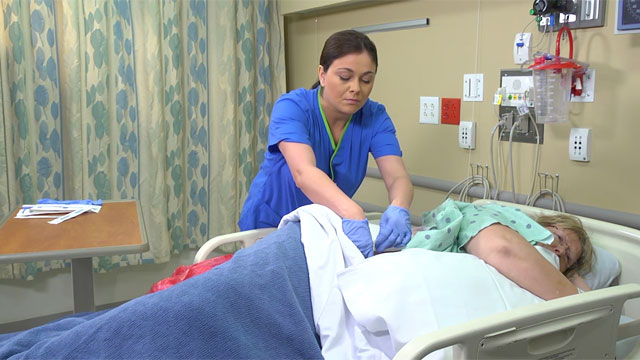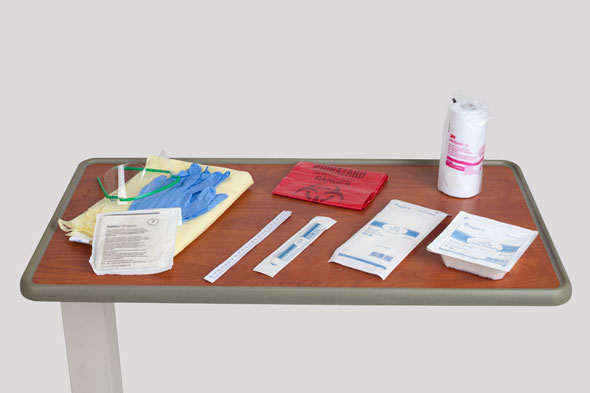Wound and Pressure Ulcer Care
Select a Skill:
- » Assessing Wounds
- » Irrigating Wounds
- » Changing a Dressing
- » Using Wound Drainage Systems
- » Caring for Pressure Ulcers
Take the Review Test:

Safety
- Wear gloves because of the risk of contact with infectious microorganisms.
- Follow the principles of sterile technique when assessing a surgical wound.
- Follow the principles of clean technique when assessing a nonsurgical wound.
- Do not remove an initial surgical dressing for direct wound inspection until the health care provider has written an order for its removal.
- Be aware of the patient’s age, nutritional status, and weight, risk factors for impaired oxygenation (such as smoking), hemoglobin/hematocrit values, and chronic diseases or exposures, which can all affect wound healing.
Equipment
(Roll cursor over items to see labels)

Clean gloves
Sterile gloves (if needed)
Gown
Goggles (if needed)
Measuring guide for wound assessment
Cotton-tipped applicator
Dressing supplies
Dressing supplies
Disposable biohazard bag
Delegation
The skill of wound assessment may not be delegated to nursing assistive personnel (NAP). It is your responsibility as the nurse to assess and document wound characteristics. Before delegating related tasks, be sure to inform NAP of the following:
- Explain the need to report drainage from the wound that is present on sheets or as strike-through from the dressing.
- Emphasize the importance of reporting the presence of odor in the area of the wound.
Preparation
- Determine your agency’s approved wound assessment tool, and review the frequency of assessment. Examine the last wound assessment to compare it with the upcoming assessment.
- Assess the patient’s comfort level or pain on a scale of 0 to 10, and identify any symptoms of anxiety.
- Explain the wound assessment procedure to the patient.
Follow-up
- Compare the wound assessment to the previous assessment, and determine progress toward healing. If there is no improvement, or if you notice deterioration, consider a wound care consultation. Lack of wound healing is often related to infection. Notify the health care provider and wound, ostomy, and continence (WOC) nurse or team.
Documentation
- Record wound assessment findings, and compare your assessment with previous wound assessments to monitor wound healing.
Review Questions
1. A patient who had surgery yesterday has the initial dressing covering the surgical site. What is the nurse’s responsibility in assessing this patient’s wound?
 Remove the dressing, inspect the wound, and reapply a new dressing.
Remove the dressing, inspect the wound, and reapply a new dressing. Inspect the wound and reapply the surgical dressing every 2 hours.
Inspect the wound and reapply the surgical dressing every 2 hours.  Inspect the wound, and keep the dressing off until the health care provider arrives.
Inspect the wound, and keep the dressing off until the health care provider arrives.  Wait until the health care provider orders the removal of the surgical dressing.
Wait until the health care provider orders the removal of the surgical dressing.
2. Which wound would be allowed to heal by secondary intention?
 Cleft lip repair
Cleft lip repair Infected hysterectomy incision
Infected hysterectomy incision Exploratory laparoscopy incision
Exploratory laparoscopy incision Facial laceration caused by a pocket knife
Facial laceration caused by a pocket knife
3. Before performing a wound assessment, which nursing action would reduce the patient’s risk for infection?
 Taking the patient’s temperature
Taking the patient’s temperature Applying clean gloves
Applying clean gloves  Assessing the wound for drainage
Assessing the wound for drainage Assessing the dressing for drainage
Assessing the dressing for drainage
4. Which intervention can the nurse delegate to nursing assistive personnel (NAP) in caring for a patient with a wound?
 Assessing the site for signs of redness or swelling
Assessing the site for signs of redness or swelling Reporting the presence of wound odor
Reporting the presence of wound odor Removing a soiled outer dressing
Removing a soiled outer dressing Opening sterile dressings during the dressing change
Opening sterile dressings during the dressing change
5. The nurse notes that a patient’s surgical wound is healing slowly. Which health problem would contribute to slow wound healing?
You have completed the Review Questions for this skill. To take the Review again select the Start Over button. To proceed to another skill select from the dropdown menu. Select the Home or Back button to proceed to the next section.

